Of the myriad possibilities for expression,
I was most taken with moving imagery, with film.
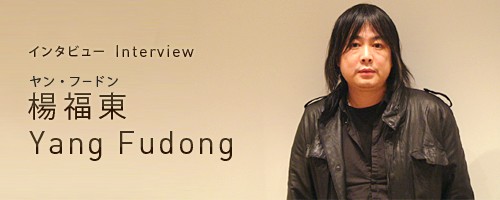
Lyrical images, rendered in exquisite composition and camerawork. Somehow magical, the realm of Yang Fudong’s art yet takes us on a journey through the souls of people living in today’s China. We caught up with Yang, who in recent years has been venturing into new stylistic and thematic territory, in Tokyo on the occasion of his first Japanese solo show.
Interview/text: Oyama Hitomi
– The five works on show here were produced in different years, but do they have a common theme?
Life itself, survival, and the way people live – you could say these are part of all the works, even if not immediately obvious. One person might deal with things in an extremely proactive manner. Another might be very passive. People are educated differently, have different backgrounds, different understanding of society. In the process of growing up each will grasp what he or she ought to believe in, and act accordingly. To me this is something of great significance.
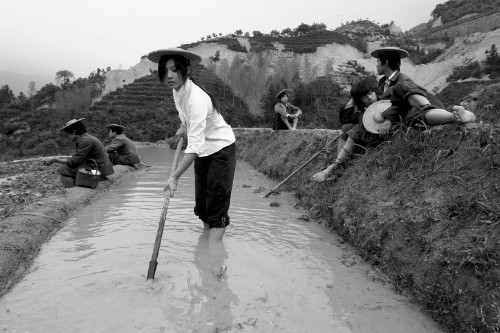 Seven Intellectuals in a Bamboo Forest Part 3 2005
Seven Intellectuals in a Bamboo Forest Part 3 200535mm B&W film/DVD 53min.
Courtesy the artist and ShanghART Gallery
– Your Seven Intellectuals in a Bamboo Forest series completed over a five year period starting in 2003 has five parts in total. Why have you chosen Part 3 for this show?
Part 3 has an entirely different theme to the other four, that of an alternative way of living. Which coincides with the theme of this show. Plus I was hoping that the works would interrelate and intersect.
– Most of your work is shot on 35mm film. Obviously you have a strong preference for film.
I personally like shooting with film. Film has a warmth to it, like a person breathing. Plus there’s something organic about the noise of the movie projector, the grainy visuals.
– At university you majored in oil painting, but can we assume it was this fascination with film that led you to start presenting your work in film and photographic form?
I suppose so. I did study oil painting at university, but after coming into contact with contemporary art, gradually realized there were media that would allow me to express myself better than painting: photography, video art, installations, performance art and so on. That when it comes to means of expression, the possibilities are legion. Of those myriad possibilities, I was most taken with moving imagery, with film.
Video installations pregnant with emotion
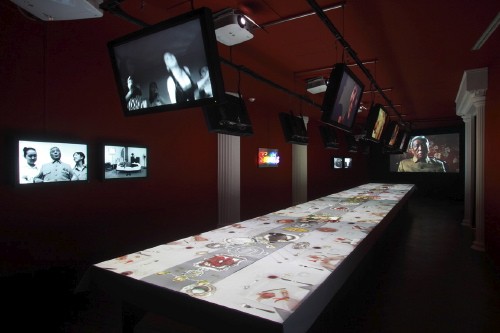 The General’s Smile 2009
The General’s Smile 2009Multiple-channel video installation
Installation view at Hara Museum of Contemporary Art, photo Kioku Keizo
– In the past few years – a perfect example being The General’s Smile, perhaps the highlight of this show – you’ve chosen to present your work in installation form. Up to then, you’d opted mainly for a two-dimensional format, projecting your work on screen. A major shift in style, as I’m sure you’d agree. What prompted you to start showing your work in installation form?
It means a lot to me that you’ve sensed the change like that. The fascinating thing about video art is that it allows you to make best use of any given space. So the idea was to try to express a fraction of my emotions spatially as well. The General’s Smile feels like a piece of theater presented in a space.
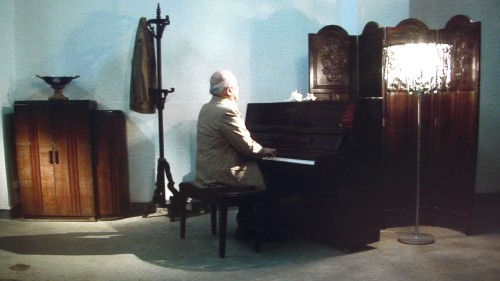 The General’s Smile 2009
The General’s Smile 2009Multiple-channel video installation
Courtesy the artist and ShanghART Gallery
– It portrays the contrast between an elderly man, and a group of young men and women, doesn’t it.
My aim was not so much to offer contrasting images as to convey how wonderful it is to be alive, regardless of age, position or prestige. The general was young once. And right now the young people are indulging in a joyful glorification of youth. Both however possess life, that most precious of things.
– If I might move on to another major shift in your practice: up to 2007’s East of Que Village your works consistently depicted unreal, dreamlike worlds, but in East of Que Village, which captures dogs in a Hebei farming village, and the Blue Kylin series (2008) also on display here, featuring people working in a stone-carving factory, for the first time you produced works documentary in tone, homing in directly on reality.
It’s true they have a documentary look to them, but in both cases, I’ve not so much aimed for realism as express a surreal, abstract sensation. After completing the final chapter of Seven Intellectuals in a Bamboo Forest in 2007, I was assailed by this feeling of emptiness, as if I’d been filming while floating in midair. Struck by a powerful urge to come back down to earth for the next work, I turned my attention to the real world. The result was East of Que Village and the Blue Kylin series. Most important I guess was the obvious shift in my personal grasp of reality.
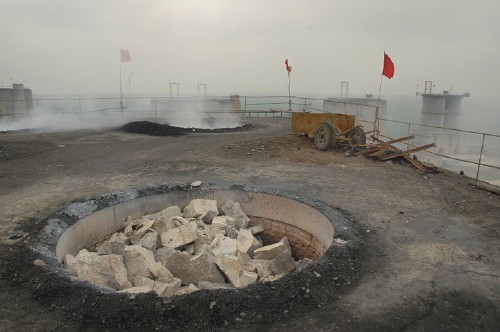 Blue Kylin Part 1 2008
Blue Kylin Part 1 2008Multiple-channel video installation
Courtesy the artist and ShanghART Gallery
‘Good faith’ as an influence on the future of Chinese contemporary art
After shooting the Seven Intellectuals in a Bamboo Forest series, I found myself able to engage with things in a very open-minded fashion. I get the feeling that up to then, I really only paid attention to what was of personal interest to me. But I learned that in fact other things can be interesting, can be a good fit for me as well. An approach that is also essential when engaging with art. A frequent topic of conversation with friends lately has been the importance of tackling things with at least the minimum ‘good faith’ required of us as human beings, as we were taught in primary school. We artists ought to apply ourselves seriously to producing work designed to truly inspire people.
– Your works seems to reflect the natural features of the northern and southern regions of China, and the particular traits of the people living in these places. You were born in Beijing in the north and went to university in Hangzhou in the south, returning to Beijing after graduation for a time before moving to Shanghai, where you’ve lived ever since. Do you think your works reflect differences between north and south?
I suppose there has been some sort of invisible influence, although just what exactly is as much of a mystery to me as anyone. I simply do my filming and put it all together in a place that matches the concept behind the work; I never consciously incorporate any regional differences.
– As an artist, what’s your view on developments in contemporary Chinese art over the past few years? The Beijing Olympics are over, and the subsequent global financial crisis has also had a huge impact on the art world. I see a shift too in the mentality of Chinese artists.
The impact of the financial crisis helped make 2009 a year for artists, like many others, to sit back, take stock, and ask themselves a few questions about what they really want to produce, and what they ought to be doing. I suspect the artists that will last the distance are those able to return to their mindset as students first studying painting, engage with their work in good faith, maintain this state of mind and really be capable of loving art.
– I’m sure you have lots more changes in store for us in your practice.
At the moment I’m working on ideas for a piece shown on seven or eight screens, incorporating the most basic structures of cinema. Plus in 2010, if the opportunity arises I’d like to make a full-length feature. I’m thinking a storyless, soporific sort of piece (laughs).
Yang Fudong
Born 1971 in Beijing. One of China’s leading young artists, Yang’s practice includes numerous video works shot on film that have been highly acclaimed for their tranquil ambience, and their style, that of fictitious realms that nevertheless capture the true essence of things. Known internationally for works such as his Seven Intellectuals in a Bamboo Forest series, a closeup view of the inner lives of young people in China today inspired by the Chinese tradition of wise men escaping worldly cares to converse eloquently in a forest of bamboo. More recently Yang has extended the formats he deploys to the likes of installations as a form of spatial expression, including some using multiple screens. The General’s Smile is his first solo show in Japan, and runs from 19 December 2009 to 23 May 2010 at the Hara Museum of Contemporary Art.
Hara Museum of Contemporary Art
http://www.haramuseum.or.jp
ART iT ArtPatner: Hara Museum of Contemporary Art
https://www.art-it.asia/en/u/HaraMuseum_e/
ART iT Snapshots: Yang Fudong: The General’s Smile
ART iT Picks: Yang Fudong: The General’s Smile
